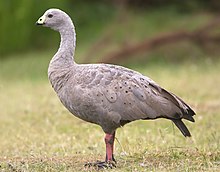Cereopsis
| Cape Barren goose | |
|---|---|
 |
|
| Scientific classification | |
| Kingdom: | Animalia |
| Phylum: | Chordata |
| Class: | Aves |
| Order: | Anseriformes |
| Family: | Anatidae |
| Subfamily: | Anserinae |
| Tribe: | Cereopsini |
| Genus: |
Cereopsis Latham, 1801 |
| Species: | C. novaehollandiae |
| Binomial name | |
|
Cereopsis novaehollandiae Latham, 1801 |
|
| subspecies | |
|
C. n. novaehollandiae Latham, 1801 |
|
 |
|
| Distribution of the Cape Barren goose | |
C. n. novaehollandiae Latham, 1801
C. n. grisea (Vieillot, 1818)
The Cape Barren goose (Cereopsis novaehollandiae) is a large goose resident in southern Australia. The species is named for Cape Barren Island, where specimens were first sighted by European explorers.
The Cape Barren goose was first described by English ornithologist John Latham in 1801 under the current binomial name. It is a most peculiar goose of uncertain affiliations (Sraml et al. 1996). It may either belong into the "true geese" and swan subfamily Anserinae or into the shelduck subfamily Tadorninae as distinct tribe Cereopsini, or be separated, possibly including the prehistorically extinct flightless New Zealand geese of the genus Cnemiornis, in a distinct subfamily Cereopsinae. Indeed, the first bones of the New Zealand birds to be discovered were similar enough to those of the Cape Barren goose to erroneously refer to them as "New Zealand Cape Barren goose" ("Cereopsis" novaezeelandiae).
The smaller population of Cape Barren goose in Western Australia is described as a subspecies, Cereopsis novaehollandiae grisea, and named for the group of islands known as the Recherche Archipelago.
These are bulky geese and their almost uniformly grey plumage, bearing rounded black spots, is unique. The tail and flight feathers are blackish and the legs are pink with black feet. The short, decurved black bill and green cere gives it a very peculiar expression.
...
Wikipedia

